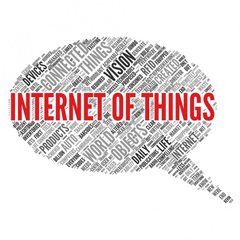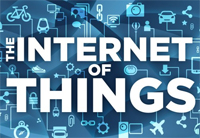Have you heard about the Internet of Things and how it could change our world?

In other words, IoT is an environment where information is collected from multiple devices with sensors that use the Internet as a communication backbone in order to transmit this information to a system that can analyze it.
Today, every person is connected to the Internet, and in the very near future every thing in the our environment will have a sensor that can transmit information to the Internet, so we will be able to manage room temperature, control our energy consumption, and manage any machine or service available in our homes, and we will be able to manage and control them using our mobile phone. In addition machines' manufacturers will communicate remotely in order to upgrade or support them.
What are Things?
Things could be anything, including (*but not limited to) goods, objects, vehicles, buildings, people, animals, machines, plants, and soil.
How will we do that?- Assign a Unique Identifier for every Thing
- Provide the ability for every Thing to communicate
- Install a sensor for every Thing, then gather data
- Use a system or controller to monitor, manage or control the Thing from anywhere
Why is the Internet of Things important?

When every Thing is represented digitally and has connectivity, we will be able to collect, learn and interact with anything.
These are the tangible benefits we will get from the Internet of Things:
Monitor Things
We can monitor almost every thing, such as a bicycle or camera, or our family members.
We will be able to monitor movements, location and activity levels. A wearable sensor can read your biometrics, heart rate, respiration rate and blood pressure, collecting data and transmitting to your physician. There are many applications available for other Things as well.
Track or Search for Things
We will be able to use real-time search engines to search for our cars, kids or pets. We can easily track our lost keys or electronic gadgets in our home.
Manage Things
Because we can collect more data, we have more knowledge, which will allow us to better manage our Things. For example, we'll be able to navigate traffic to eliminate congestion, or manage energy consumption.
Control Things
Because we'll be able to monitor and manage our 'smart home', we can control our appliances more efficiently. Smart thermostats using sensors, real-time weather forecasts, and the actual activity in our homes during the day or night, will allow us to reduce monthly resource consumption (electricity, water, etc.) and help us to save money on utility bills. Smart electricity outlets will allow us to remotely control from anywhere in the world to turn any connected appliance or device on and off.
Play with Things
Many modern games are being enabled with augmented reality (AR), which means we can use our room furniture, or surfaces that we're surrounded by, as game objects and make them part of the game. Many Kinect, PS4, iPhone and Android games exist, where you can race a car, solve puzzles, place virtual objects, search for treasure and much more, all in augmented reality.
IoT by the Numbers
According to Gartner:
26 billion units will be installed by 2020. IoT product and service suppliers will generate incremental revenue exceeding $300 billion, mostly in services, by 2020.
Also by 2020, the number of smartphones tablets and PCs in use will reach about 7.3 billion units. The incremental IoT supplier revenue contribution from IoT by 2020 is estimated to exceed $309 billion. Economic value-add (which represents the aggregate benefits that businesses derive through the sale and usage of IoT technology) is forecast to be $1.9 trillion across sectors by 2020.
According to Cisco:
There will be 25 billion devices connected to the Internet by 2015 and 50 billion by 2020.








